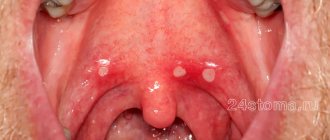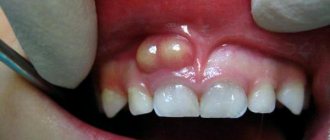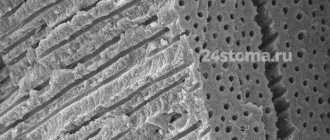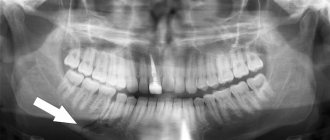Flux on the gums is an extremely unpleasant, but quite common phenomenon, which is an inflammatory process in the periosteum area. The word “flux” is of German origin and is translated as “flow, flow.” Today, this term is not commonly used in professional circles. Instead, experts use the scientific name of the disease - odontogenic periostitis. In most cases, it overtakes the most patient patients who diligently avoid visiting a professional dentist for a long time. As a result, due to laziness or fear of the dentist, the patient receives severe swelling of the gums, constant dull pain, and in some cases, high fever.
Despite the fact that the phenomenon in question cannot be called a rarity, this does not make it any less harmless. The advanced form of periostitis is quite dangerous, so the health of the oral cavity and teeth should be taken as seriously as possible, and at the first signs of inflammation you should consult a specialist as soon as possible.
Causes of the disease
Patients often blame the careless work of dentists for the development of inflammatory processes in the oral cavity. Thus, “flux after wisdom tooth removal” is one of the most discussed topics on dental forums. In fact, the most common causes of periostitis are gum trauma and untreated tooth decay. Often the situation is complicated by the patient’s reluctance to visit the dentist in a timely manner. As a result, food debris inevitably accumulates in places of damage, which eventually begin to rot. Further, the pus accumulates and then begins to rapidly spread, affecting healthy tissues of the oral cavity.
The most common causes of gumboil are damage to the gums, poor oral hygiene and caries.
Treatment of flux on the gums with folk remedies cannot guarantee a high-quality result. Most often, self-prepared medicinal products can only suppress the pronounced manifestations of the disease, and not eliminate the causes of its occurrence. For this reason, when the first symptoms of periostitis appear, it is important to undergo high-quality flux treatment in dentistry, which can guarantee complete relief of the inflammatory process.
What happens if you don't undergo therapy?
It is unacceptable to treat purulent gum lesions as a minor dental disorder. It is very insidious and rarely disappears without a trace on its own. Often, if treatment is refused, the following occurs:
- Abscess. It is a consequence of a long-term presence of a pus-filled sac in the area of the tooth root. The abscess grows and then ruptures.
- Phlegmon. Represents an extended lesion. It usually occurs after a rupture of a purulent sac, if the patient does not comply with the dentist’s instructions, does not rinse the mouth with a special antiseptic solution, or apply anti-inflammatory gels.
- Osteomyelitis of the jaw. It occurs if the gums are not treated for a very long time. The pathological process spreads to the jaw bone, which is very dangerous.
- Inflammation of individual sinuses of the skull. It is also diagnosed with advanced periostitis. The maxillary, frontal and sphenoid sinuses are affected.
It is extremely rare that the disease affects brain tissue. Then the person may even die.
Symptoms of gumboil
Symptoms are expressed in the appearance of a purulent sac or thickening of the gum area. The photo shows a clear example of gumboil on the gum. It is this infiltrate that is the main sign of the development of the disease. Experts distinguish two main forms of periostitis:
- The acute form is accompanied by severe toothache, severe tissue swelling, and swelling of the cheek. As the disease develops in the lower jaw, inflammation of the lymph nodes and swelling of the chin may occur. Often the advanced form of the disease causes elevated body temperature.
- The chronic form of the disease proceeds slowly and imperceptibly, which is its insidiousness. Often there is thickening of the jaw bone in the affected area. Despite the fact that there are practically no pronounced symptoms in this case, the consequences of this form of flux are no less dangerous.
Why does it occur
In order to understand how to remove flux, it is necessary to establish what led to its appearance. If the provoking factor is not eliminated, the disease may return. Among the main reasons for the violation:
- untreated deep caries;
- a large amount of hard plaque extending far under the gum;
- dental root cyst;
- inflammatory lesion of the gingival pocket;
- receiving mechanical injuries;
- general hypothermia of the body (especially against the background of reduced immunity);
- poor oral hygiene.
According to statistics, most often the disease occurs precisely because of advanced caries and pulpitis. If there is a large “hole,” the infection easily penetrates deep into the dental tissues, affects the surrounding structures and causes nerve destruction. Then pulpitis develops.
If left untreated, it will become chronic. The pain will become mild, but this does not mean that the disease has gone away. It’s just that now it’s happening secretly. The infection will continue to destroy the internal structures of the diseased unit. As they die, narcotic masses will begin to be released. To remove them, an abscess forms on the gum. This is flux.
If it is localized on the periosteum of the upper jaw, then the upper lip and the area under the eye swell. If inflammation progresses in the lower jaw, the chin and cheek swell, and the lymph nodes become painful.
Diagnostics
Before proceeding with dental flux treatment, the doctor must conduct an appropriate diagnostic examination. The exact diagnosis is determined based on data obtained during a clinical examination and x-ray diagnosis. Laboratory tests allow you to accurately determine the stage of the inflammatory process. Only after making an accurate diagnosis will a specialist be able to decide what to do with gumboil and which method of treatment in this particular case will be optimal.
Medication options
You can also use some professional techniques at home, in particular drug therapy. First of all, this is taking a course of antibiotics .
However, it is highly undesirable to do this without consulting a doctor.
The following solutions are also suitable as a therapeutic rinse:
- Chlorophyllipt;
- Vinylin;
- Hexoral;
- Hepilor and others that have an antimicrobial effect.
You can also use crushed Furacilin tablets.
How to treat flux?
If your tooth hurts and gumboil appears on your cheek, you shouldn’t panic and look for something to rinse your mouth with. “Grandmother’s” treatment methods really help get rid of acute pain and relieve some swelling, but they have not yet helped anyone cope with purulent compaction, which is the main danger. How and with what to treat flux? How to remove gumboil in case of gum inflammation? Only a qualified dentist can give detailed answers to these and other questions.
Self-medication with folk remedies will only help dull the pain and relieve swelling a little. Only a qualified dentist can completely remove pus and eliminate the cause of inflammation.
How is flux treated in dentistry? Currently, there are two main methods of treating gumboil on the cheek:
- Opening the pus sac, in which the doctor removes the accumulated pus through a small incision. The procedure is performed under anesthesia. After removing the pus, the specialist installs a drainage at the site of the incision - a special rubber strip that ensures the outflow of pus and prevents the wound from healing ahead of time.
- Cleaning an abscess through a root canal is necessary if the inflammation is a consequence of caries or a crack in the tooth.
Often in advanced stages of the disease there is a need for tooth extraction. Typically, this procedure is carried out when there is deep destruction of the causative tooth or if there is a large infected area between the tooth and the gum. Removal is also used if there is a sufficiently large crack in the tooth that cannot be treated.
Typically, the doctor begins by making an incision into the periosteum or lining of the mouth. The causative tooth is usually removed gradually, that is, in parts. For this, a special dental saw or laser is used. Modern equipment has made it possible to make the procedure for tooth extraction quick and completely painless, so there is no need to be afraid of treatment. After the operation, the sharp edges of the incision are smoothed, which is then washed with peroxide or other antiseptic agents and fixed with sutures.
Content:
- Why does it occur
- Signs
- How it proceeds
- Features of the development of periostitis in children and adults
- What happens if you don't undergo therapy?
- How to remove flux
- How to speed up recovery
- Preventive actions
An inflammatory dental disease that affects the periosteum tissue is called periostitis by dentists.
It is popularly known as flux. It is easy to recognize on your own - a painful abscess forms on the gum, which does not go away for a long time. It is unwise to fight this disease without medical help. When it appears, you should definitely make an appointment at a dental clinic and, during an in-person examination, find out from the doctor how to remove the flux without negative consequences for health.
It is simply impossible to ignore periostitis. It is usually accompanied by acute throbbing pain. Sometimes it can even lead to fever and a sharp decrease in performance. When there is a lot of pus in the “bag”, it bursts. Then the purulent masses flow out, and the symptoms cease to be so bright.
Antibiotics for flux
As noted above, flux is a consequence of a bacterial infection, which is often treated by taking antibiotics. Many, at their own peril and risk, try to cope with inflammation by independently taking quite strong medications that can cause serious damage to the health of the entire body. Effective and at the same time safe treatment of flux with antibiotics can only be prescribed by a qualified specialist.
Antibiotics for flux are prescribed by a doctor individually. Self-use of strong medications is fraught with serious consequences for the entire body.
Antibiotics, like anti-inflammatory drugs, are used in dentistry for flux as part of complex maintenance therapy. The only way to stop the inflammatory process and remove the pus is surgery. Antibiotics are usually prescribed at the very beginning of treatment if the disease is in the earliest stages of its development, but identifying such inflammation at the initial stage can be quite difficult. As a rule, the dentist is able to detect the very first signs of periostitis by accident, for example, during a routine examination of the oral cavity. The specialist prescribes antibiotics for flux individually, depending on the characteristics of the patient’s body and the general clinical picture.
Stages of flux development
initial stage
In its initial form, the flux makes itself felt only minimally. It can be suspected if there is a lump on the gum, as well as slight pain. If detected early, periostitis is treated with conventional anti-inflammatory drugs in combination with painkillers. Conducting an initial examination, the dentist assesses the condition of the tooth root. The question of the appropriateness of treatment is being decided. But, as a rule, at this stage, the tooth can almost always be saved.
Flux: initial stage
Acute stage
If the early stage has passed the patient’s attention, the formation of a purulent sac begins. A dental surgeon makes an incision in the gum. The accumulated pus is removed, followed by treating the cavity with antiseptics. Antibiotics are prescribed. The period of their admission is determined by the attending physician.
Flux: acute stage
Advanced stage
Further lack of treatment is fraught with the penetration of pus into the soft tissues and further into the internal organs of the whole body. This provokes the appearance of phlegmon - a disease that is extremely life-threatening.
Flux: advanced stage
Flux - treatment in children
If a child has flux, you should never give him medications on your own, and especially antibiotics. Only a dentist can prescribe a medicinal course of treatment. Antibiotics destroy both pathogenic and beneficial bacteria that help fight infection, so the unauthorized use of such serious drugs can lead to negative consequences for the child’s entire body.
Treatment of gumboil largely depends on the causes of its occurrence. So, this process is not much different from the treatment of periostitis in adult patients. As a rule, to begin with, the specialist makes a small incision in the area of the inflammation and ensures the outflow of pus using a special drainage system. The treatment then continues at home under the supervision of parents. Most often, a complex of medications is prescribed, but in some cases, a specialist may allow you to limit yourself to rinsing with special decoctions and solutions.
Traditional recipes and techniques
First of all, we should talk about folk recipes.
The beneficial properties of many medicinal plants are used here, as well as their combinations in various proportions. They quite successfully help fight this disease in both adults and children. Some of these methods are recommended by doctors themselves , especially by prescribing a list of therapeutic and restorative procedures simultaneously with the use of professional techniques.
It is these methods of combating flux at home that are given more attention here, since they are the simplest of all available.
It should also be noted that the vast majority of these means and methods are safe to use . If you follow the simplest recommendations correctly, then such treatment will definitely not cause harm.
The only thing worth noting when talking about precautions is to check for an allergic reaction to one of the components.
Rinse
One of the indispensable components of traditional methods of treatment is frequent rinsing of the mouth using a variety of tinctures and decoctions of medicinal plants, as well as some solutions.
Most of these products have an antibacterial effect. They also help relieve general inflammation, thereby reducing the intensity of pain.
Soda with salt
This recipe can be called basic in the case of not only home treatment, but also recovery from a variety of dental problems and ENT diseases.
In a glass of warm water, mix half a teaspoon of baking soda and salt. Dissolution must be complete.
You should rinse once every half hour in case of severe inflammation and advanced problem. If flux is noticed at the initial stage, then the intensity of the procedures can be reduced by 2-3 times, that is, rinsing once every hour and a half.
Using these two components simultaneously will prevent the development of the inflammatory process and reduce it.
Sage
Dried flowering tops and leaves of sage herb are successfully used in the fight against various inflammatory processes, even internal ones. For flux, use a tincture of this plant.
- To do this, you need to brew two tablespoons of sage (about 10 grams) and one spoon of dry mustard herb in one and a half glasses of .
When the tincture has cooled sufficiently, it should be strained well. Rinsing is carried out quite often - 8 times a day, that is, approximately every two hours. - Another recipe calls for a mixture of sage, oak bark and St. John's wort .
You need to take 50 grams of each plant. All this is brewed in a large amount of boiling water (about a liter). When the tincture has been filtered and cooled, it is used for rinsing every hour and a half. - Another option for using sage is to mix 60 grams of the herb with the same amount of green leaf tea and brew in one liter of boiling water.
This tincture can be used at a higher temperature, meaning there is no need to wait for it to cool to room temperature.
Birch buds
Essential oils and other components of birch bud decoction have antimicrobial and antispasmodic effects. It is thanks to this that tinctures using them are successfully used to treat gumboil.
- To prepare it you need to take 60 grams of the buds themselves, periwinkle, angelica and peppermint . The resulting mixture is poured with boiling water (a little more than a liter), cooled, settled and filtered. Rinse your mouth with this tincture 6 to 8 times a day.
- Another version of the same tincture is alcohol. In this case, the mixture should be infused in an alcohol solution (about 40%) for about a day or two .
The effect is enhanced by alcohol, which is an excellent disinfectant. Before rinsing, dilute the tincture with boiled water at room temperature - 1-2 tablespoons per glass.
Rinse Ingredient Notes:
- Mustard is used as a fairly strong painkiller.
- St. John's wort contains a lot of useful components, thanks to which it is used as an analgesic, antiseptic, and antispasmodic. It also speeds up regeneration.
- Tannins, as well as some enzymes contained in oak bark, have a negative effect on pathogenic microorganisms and also reduce tissue inflammation.
- Angelica exhibits strong anti-inflammatory properties.
- Peppermint, among other things, has a soothing, anti-inflammatory and antibacterial effect.
- Periwinkle is used as a sedative, antimicrobial, and vasodilator.
In addition to the above plants, you can also use elderberry, chamomile, lemon balm, rue, etc. to prepare a decoction or tincture for rinsing the mouth during gumboil.
We will tell you which is the best oral irrigator to choose by considering the design features of such devices.
In this article, we will find out which teeth are best to insert during prosthetics.
Here: https://zubovv.ru/detskaya-stomatologia/d-zubi/skrezhet-bruksizm-vo-sne.html - watch the video and find out what Dr. Komarovsky says about bruxism in children.
Ointments and compresses
In this section, first of all, cold compresses should be mentioned as an excellent remedy for relieving swelling and relieving the condition .
Cold helps stop the active development of inflammation. With its help, all processes occurring in tissues are locally slowed down.
It must be added that any compresses used can under no circumstances be hot . For the most part, room temperature is sufficient.
The fact is that when tissues, especially inflamed areas, are heated, the proliferation of pathogenic bacteria, which provoke this process, accelerates.
Any infusion or rinsing solution prepared earlier is suitable for preparing a compress. Gauze, folded several times, is well moistened in the prepared tincture and applied directly to the site of swelling.
Soda
Soda is also used as a component of a compress. Place a teaspoon of baking soda in a thick but small gauze swab.
Immediately before use, the gauze is moistened with water. You should keep this compress for about an hour, after which you must rinse your mouth additionally .
Cabbage
The medicinal properties of cabbage make it possible to use its leaves also in the fight against gumboil. A clean, dense leaf of ordinary white cabbage is boiled in water for several minutes.
After cooling, the sheet is applied to the cheek in the area of inflammation and swelling. The leaves cannot be reused, including for food.
Bulb onions
This plant is a natural rather strong antiseptic. In addition, onions contain a huge number of components that have a healing effect.
To prepare a compress, squeeze the juice from one whole onion. A piece of gauze folded four to eight times is soaked in the resulting liquid (you can use a regular bandage, not even a sterile one). The compress is applied for half an hour to an hour.
Eggs and sugar
Sugar is a long-standing natural preservative. That is why its mixture with egg yolk, as well as a spoonful of vegetable oil (olive, sunflower), can be used as a filler for a compress.
It is prepared as in other cases using a gauze swab. But you need to keep it on the gum for much less time - only about 20 minutes.
Ointment
To prepare an effective ointment, you can use a specially prepared antibacterial mass, to obtain which you will need honey and a rusty nail . It doesn't have to be a nail.
You can take a piece of iron wire or another iron product on which oxide has formed, that is, rust.
The metal must be heated very hot over the fire. After this, it is placed in fresh honey, previously poured into a small saucer.
As a result, the black mass that forms around rusty metal in combination with honey is used. It is black in color.
What types of attachments are there for an Oral Bee electric toothbrush, what are their features.
This review contains recipes for treating periodontal disease at home.
Here: https://zubovv.ru/lechenie/bolezni-polosti-rta/stomatit-bpr/stomatofit-podrobnaya-instruktsiya-po-primeneniyu.html - we’ll find out the price and find instructions for the drug Stomatofit.
How not to cause harm?
What to do if flux appears? Some patients mistakenly believe that swelling and severe toothache can be relieved on their own with the help of warming compresses, herbal infusions and other folk remedies. Unfortunately, such health experiments often end very badly. Thus, in order not to inadvertently harm yourself and provoke further development of the disease, the following contraindications should be observed:
- No warming compresses that contribute to the spread of periostitis.
- Never take painkillers less than 3 hours before visiting the dentist. Otherwise, you can significantly complicate the diagnosis process.
- After opening a purulent lesion, you should not take aspirin. It can provoke bleeding, especially since it is completely useless as a pain reliever in this case.
- If your condition has not improved 12 hours after surgery, you should see your doctor again.
How to speed up recovery
To make healing go faster, it is important not only to follow the dentist’s instructions, but also to remember the rules:
- do not heat the area where the pus was located;
- do not take antibiotics or any other medications unless prescribed by a doctor;
- do not use any folk recipes without consulting your doctor;
- Until the wound is completely healed, do not use aspirin or any medications that contain acetylsalicylic acid.
If the “bump” appears again, it is recommended to immediately contact a dental clinic.
What to do after removal or opening?
After opening the flux, you should not wait for the swelling to disappear immediately. Many patients feel that the flux does not go away after tooth extraction, although this is not the case at all. In some cases, the swelling may increase slightly after the procedure. Approximately on the third day after surgery, the patient should make a dramatic recovery, but the infiltration may remain for quite a long time. Within a few hours after the operation, the toothache in the area of the lesion should disappear and the body temperature should decrease.
Usually the swelling goes away only a few days after opening the purulent focus. Do not be alarmed if the swelling increases slightly after surgery.
The specialist installs a special rubber drainage in the incision, which you should never try to fix yourself. Otherwise, the recommendations are the same as for regular tooth extraction. You should not eat for several hours after the procedure. During the day, try to avoid hard and rough foods, as well as hot drinks. Regarding the use of medications in each individual case, the specialist gives individual recommendations.
Signs
You can understand that periostitis has developed by the following symptoms:
- tooth pain;
- swelling of the gums;
- an abscess at the base of the diseased unit;
- increased pain when pressing on the affected area;
- swelling of the cheek;
- increased body temperature;
- swelling of the lymph nodes.
If these symptoms occur, you should make an appointment with the dentist as soon as possible. In the early stages, the problem can be eliminated quite easily and quickly. Delay is fraught with health-threatening complications.
Treatment prices
The cost of flux treatment largely depends on the severity and severity of the disease, as well as on the method of therapy chosen by the specialist. It is worth noting that modern medicine offers all the possibilities for quick, effective and completely painless elimination of the causes and consequences of periostitis. In addition, the price for flux treatment is influenced by factors such as the level of prestige of the dental clinic, the cost of the equipment and materials used, and the level of qualifications of the practitioners.
Preventive actions
To reduce the likelihood of periostitis, you need to take care of your teeth and visit the dentist at least once a year. You can't start caries. As soon as a dark spot appears on the surface of the dental crown, it needs to be treated.
After eating, it is advisable to rinse your mouth with warm water. To make hygiene as high as possible, it makes sense to use not only a brush and toothpaste, but also dental floss and irrigators. It is very important to remove tartar every year at the dentist's office.
An important place in the issue of prevention is given to diet. You should eat as much fresh fruits, vegetables, and plant foods as possible. They require more thorough chewing and thus have a positive effect on the ligamentous apparatus that holds the tooth. They also provide natural cleansing of crowns from soft plaque.
If you have any questions about how to remove flux, please contact the doctors at the Line of Smile dental clinic for help. We specialize in the treatment of this disease and know how to quickly rid our patients of it.
How to recognize periostitis?
Adults suffer from flux much more often than children. Note that such inflammation is accompanied by a number of symptoms, so it immediately makes itself felt.
Signs of classic purulent flux:
- the mucous membrane hurts a lot
- soft periodontal tissues become inflamed and swell. The cheek swells on the side of the localization of the pathological process
- lymph nodes increase in size
- body temperature rises to +38 degrees
It is worth understanding that periostitis does not go away on its own. Some patients are sure that after the purulent contents flow out of the burst lump, there is no need to treat the inflammation. They say it went away by itself. However, this is a misconception and in this case a dental clinic will definitely be required. After all, it is possible to completely get rid of pus only by installing a special drainage and carrying out certain therapeutic measures prescribed by the doctor. If flux treatment is started on time and carried out correctly, then the pathology can be eliminated in 12-14 days. If the form is advanced, recovery will take more than a month.
What is the danger of flux?
This pathology is characterized by the development and further damage to deep periodontal tissues. If left untreated, periostitis takes on the most severe forms and leads to infection of the entire body, which can even lead to death. Therefore, it is important to undergo a preventive dental examination and not delay treatment. The doctor will be able to recognize the pathology in time and take measures to prevent the development of inflammation. This will allow you to save your teeth and avoid various complications that gumboil left unattended can cause.
How can a dentist help if a patient has developed gumboil?
As a rule, advanced flux requires surgical dental intervention - that is, a dental surgeon opens the periosteum and gums and inserts a rubber tube there to remove the purulent contents. In this case, the tooth most often cannot be preserved for further restoration and is completely removed. To combat inflammation, the patient is prescribed antibiotics and antihistamines.
If the flux has just begun to develop, then perhaps there will be no need to cut the tissue - the doctor will simply open the tooth canals, treat them with an antiseptic and antibiotic, and the pus will come out on its own - in the few days that must pass before the next visit to VivaDent and filling the canals .
In any case, the decision about what treatment should be in a particular case - conservative or surgical - will be made by the dentist only after receiving x-rays of the tooth and the tissues around it.
Anti-inflammatory drugs
You can quickly relieve swelling and reduce pain at home with flux using anti-inflammatory non-steroidal drugs. They are available in the form of tablets, suspensions, and powders.
"Nimesil"
The main anti-inflammatory “dental” remedy. The main component is nimesulide. It has a strong anti-edematous, anti-inflammatory effect, and to a lesser extent – antipyretic and analgesic. These properties make Nimesil the No. 1 drug in the treatment of periostitis.
The main component is nimesulide.
The medicine is prescribed for adults and children over 12 years of age, 1 sachet twice a day. It is not recommended for patients with disorders of the intestines, liver, heart or during pregnancy.
The price of one sachet of “Nimesil” is 20–30 rubles.











